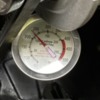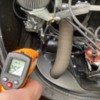Hi all, new to my speedster, but took it for a spin on the highway for the first time, about 10 minutes in, my oil gauge was close to being pinned. Not quite and never got any higher than this photo, but any help would be appreciated. Thanks!
Replies sorted oldest to newest
Do you know if all your sled tins are in place? When you open up the engine compartment, can you see the ground under the engine?
I am not at the car so cannot check this second. Assume that it should not be close to pinned though? Newbie, so learning as I go.
Where did you get the car?
Id get a real oil temp gauge, the one U have is notoriously inaccurate
Assuming you are running a vw engine, when you look into the engine compartment it should be sealed. you shouldn't be able to see the ground. There are several sheets of formed tin that are attached to the bottom of the engine to funnel heat away from it. The engine compartment itself is sealed to prevent that heat from rising into the compartment.
There is plenty of discussion on this site in various threads discussing how this system works and why it exists.
If any of these heat controlling/dissipating parts are missing, an engine will probably run hot.
Was the needle indicating mid range heat before you got on the highway, and how long had you been driving it before you got on the highway?
Hi Marc,
As you will soon learn, if you didn't already know it, car guys like to disagree about absolutes, i.e., how high can oil temps get with no danger to internals? Most would say for our a/c engines, somewhere around 230-240F is worrisome.
I suggest you do some sleuthing. First thing to establish is gauge accuracy. Buy an inexpensive long-probe thermometer, one that will fit into your oil dipstick hole. Others have mentioned candy thermometers work well. You want to determine oil temp with the gauge you have. You need to know oil temp when the gauge is pointed as your pic shows. Naturally, prior to testing, you make sure oil level is correct.
There are a few steps to figure out what you have to go through: 1) is my oil temp too high; 2) what steps to reduce oil temps. If your gauge is correct, and temps are too high, there are solutions with oil coolers, fans, that will usually cure the problem.
High ambient air temp and load are the two usual causes of high oil temp, assuming engine tins are in place and functional. I know others will chime in. Relax, pardner, this is a fixable problem.
Jim, today was only about 70 degrees here and me and the bride in the car. Silly question on the long probe thermometer, how do you measure, simple pull over and see whats cooking? Normally oil temp is in the middle of the gauge and levels are good. I think your points make sense, figure out if it is the gauge or something else.
Bob, I will read those posts and take a look at the engine. Gauge was moving up slowly and started to rise after we hit the highway for a little bit. Kept at 60, did come down once we had gotten off the highway it went back to mid point. Some smoke out of the vents when I was done driving. Have not put many miles on it since out of storage so thinking that is to be expected.
Jim's comments and recommendation are on the money IMHO!
I have seen cars that have been in storage have mice nests built inside the fan shroud and on top of the cylinders. This is very bad because the nesting material blocks the cooling fan air from doing it's job. You can pull the spark plugs and look into the remaining cooling tin holes to see if there is nesting material on top of the cylinders. I have had this happen more than a few times with VW engines and Corvair Engines. Keep a cool head and you will get this figured out..all part of the fun and charm of our cars.
I will check for sure!
Marc,
When you shop for a temp gauge, first measure the distance on your dipstick between oil level and top of the dipstick tube. Your probe will need to be at least that long. To check oil temp, you just remove the dipstick and slide in the temp gauge. Simple as that. It may be easier to find one online.
If your gauge reads high, i.e., oil temps aren't as high as indicated, that's not fatal. The more important element is to know what actual temps are at what gauge position. Some folks mark a gauge such are yours with green, yellow and red marks to indicate temp level, you know, safe, caution, and pull over.
Hillbilly gauge calibration: Take the sending unit out but leave it wired up(don't forget to have it grounded to the cars ground in some way) submerge the end of the sending unit into a cut off coke can filled with water. Heat the can until the water boils and check the gauge needle because this will be equal to 212 deg. F. or 100 C.
I have not used one of these but I ran across this:
It could be a lot of things. Crap(mouse nest, right, Jimmy!) in the fan, a loose fan belt, lean jetting, bad oil pump or jut plain old low on oil.
Hey, Marc-- welcome!
Tell us a little bit about the car and the engine, if you know anything about it. Where did you get it, what is it, etc.
Looks like maybe he bought this car?
https://www.speedsterowners.co...n-based-im-speedster
Try turning OFF the A/C and see what happens. ![]()
Yes Theron that is the car I bought. I know it came from good hands, just trying to sort some things out. I bought one of the laser temp readers and will try and determine what the actual temp is to see if it’s running hot or just a gauge issue. I think it’s running hot ad it smokes some after I drive it.
I keep a long thermometer in my car. A rule of thumb is to not trust the gauges our cars come with. I would take my car on a variety of runs, pull over, slide the long thermometer into the dipstick opening, and get a read. After a number of times, I was able to get an idea of where 200-degrees was on my temp gauge (200 on my gauge is halfway between cold and the halfway mark on my temp gauge). Once I dialed that in, I ran a few tests just to make sure it was “honest”. Every time my gauge crawled up to that point, I’d measure. And it’s always around 200-degrees at that point.
I’ll be the first to admit that my car heats up faster than I’d like. It hates traffic (as much as I do) but I guess that’s kinda a given with air cooled. My tins are tight, but I’m also not running an oil cooler. I’ve also heard that my cheap exhaust isn’t helping matters, radiating heat up into the engine compartment.
From what I have gathered over the years, high temps could be a variety of issues.
I’ll let the pros jump back in......
I hope the hand held guage is Acurate ![]()
So from all the great responses (thanks) I need to determine actual temp. Doesn’t sound like the laser’s are totally accurate so I’ll get a long thermometer. Was a perfect day in New England weather wise so need to explore the problem a little bit deeper.
Anyone have a well priced thermometer that they like? Checking online, but asking the pros.
Found an oil thermometer in my turkey frying kit!
So got the car out and on the highway and for the gauge pinned. Pulled over and had my laser gun and candy thermometer in the dipstick for accurate measuring. Oil dipstick was at 225, never got any hotter. Smoke was coming from bottom part of engine, but wondering if that is just some of the paint when it was resprayed burning off. Pics attached. Now seeing the gauge pinned is unnerving, so is 225 too hot, the guide book says that’s an ok temp to run at and could go up to 260?
Attachments
You've made a good start. I suggest you investigate further. As I stated earlier, VW experts disagree on maximum safe oil temp. St. Gene Berg, RIP, said 235 was the magic high temp. Under that was OK, over that could pull head bolts, unleash Satan's fury, move earth's orbit, etc. Others say 230, some say anything over 220 needs attention.
Not sure where you live/drive, but hotter air temps are coming, which will increase your oil temp. You may want to consider inexpensive alternatives first: inspect engine for built-up grease/oil on cooling fins. If found, clean and degrease. In other words, find the source of the "smoke" and remove it. Grease is more likely than paint.
Proper ignition timing, air/fuel ratio, and the correct multi- weight can also reduce oil temps. If you're not a wrencher, no worries. Check on this site for a reputable a/c VW shop near you, or check in with your local car/VW club. Your symptoms are common and the fix is out there. You can even find other SOC members near you with the SEARCH button at top right tool bar on this site.
As you go through the fixing stage, please keep us informed. That's how we all learn. Good luck on your project!
I resto'd this speedster for Jake, I didn't get to drive it except around the development half a dozen times before it was picked up and delivered to Marc. ….You do have a stock oil cooler in the shroud "dog house", also all tins are in place along with a bus H' foam seal and the exhaust is fine for the application. Valves were set, timing at 32 degrees at 2,500 rpm's. Your smoke you mention is more than likely the high temp exhaust header paint which is normal. With the IF gun are both sides of the engine the same temp ? Wonder if a mouse decided to build a nest on one side of the engine while it was in winter storage.
my 17 Por 911 oil runs 225 all the time,,sometimes lower but never higher
225F is border line and 235F is pull it over and investigate. I'll assume the oil is at the correct level. Did your VW guy perhaps adjusted the carbs? I'm wondering if they are now leaned out a bit. At this juncture I would confirm timing 32 degrees BTDC at 2,000 rpm's , also no obstructions at the fan inlet or to either cylinder head. I'll also suggest turning the fuel mixture screws evenly out on both carbs =1/8 turn to richen the fuel a bit. ( You can always turn them back in the same 1/8 turn ) Another temp investigating tool is to securely prop the engine deck lid open 2" and run it down the road and see wat the engine temp Is.
Hi Alan, thanks for weighing in. Nothing was done to the carbs, but I will have them take a look. The horn randomly stopped working the other day, so need to sort that out and will mention what you said above.
I will also update, I took the car for a proper 2-hour spin around the North Shore of MA, Manchester area (for those New Englanders 127 is an awesome ride). Plus add'l highway driving. Gauge, stayed pinned where the photo I posted, but I understand gauges are tricky on these cars. After the drive, no smoke, so thinking Alan's point about the paint seems correct. Yes, both sides were the same and no visible nests from what I can see. I am concerned about the higher air temps and how this will affect the oil temp so want to get it sorted out.
Marc,
This is Gordon, over near Worcester. There is a guy in Hopkinton that can certainly help. He’s a VW engine/transaxle Guy who also does other stuff.
Dana Johnson
(508) 364-7223
He built @Al Gallo a really nice engine not long ago and really knows his stuff - He’s been around doing VW things for decades. About 45 minutes from “Mahblehead” down 495 and the first exit off of 495 south after the Mass Pike. I can supply his address if you wish. Maybe worth a trip down there to get his take on what’s going on and reasonable fixes. A fairer guy you will not meet.
As a comparison, I have a 2,110cc Engine with both internal (in the fan shroud) and external (in the wheel well) oil coolers and mine runs about 205°F on a highway up to 90° ambient and I typically cruise at 75 - 80 mph.
Hi Gordon thanks for the note, we connected last fall via Bruce L. I think I will call your guy and discuss the issues. I did go out today, cruised at about 35-40 for about an hour and checked and the temp was 195. Maybe worth a drive out and see what he thinks. I’ll touch base with him.
Nice complement on that referral Gordon. ![]()
I don't think you are frying anything at 225, but it's not that hot outside yet. Getting things looked at is a good idea.
My money is on the mouse.
A mouse can cram a LOT of stuff into any nook and cranny in the process of making a nest. I've had one build a house on top of my truck's intake manifold from the underhood insulation and twice in my spare tire tool compartment with a roll of toilet paper that I had in the truck. Bastards.
If it was mine and I found any clue of a mouse house, the only way I'd feel good about running that motor, would be to remove the fan shroud and tins to clean it out as thoroughly as possible.
Since we're diligently self-isolating, my Nissan Rogue has not been used much in the past two months. That said, a mouse found it's way into the heater system and built its' own condominium in the blower cage. Following a 1A Auto Youtube tutorial on how to get the friggin blower out (It was awesome, BTW), it took me 2-1/2 friggin HOURS to remove half the dash and pedal cluster and a couple of heater actuators to get in there and with a totally contorted left arm (which is STILL screwed up), remove the single, tiny Phillips head screw locking the blower in, twisting the assembly 90º and then removing it (after I first removed a heater modulator actuator for clearance) and THIS is what I found in the blower:
Somehow, I didn't think that belonged there. Maybe THAT's why the heater rumbled mightily and hardly blew any air when I started the car? DUH!
Sucked it all out with my ShopVac, as well as the cavity for the cabin filter. Put it all back with a new, $30 Wix "Carribean-Bouganvilla- Enfused" Cabin filter and I'm back in business.
FRIGGIN RODENTS!!!!!!!!!!!!!!!!!!!!
Attachments
Do you live in a country home Gordon? That looks bad. A friend had a 325 and living in the country he kept getting mice nesting in the beemer.






